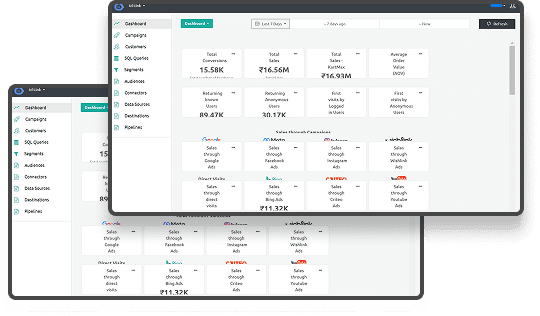Understanding Cross-Device Attribution: A Complete Guide
Are your marketing efforts being measured with just half the truth?
Most Google Chrome users, who make up around 60% of global browser traffic, will soon no longer support third-party cookies. This change limits the ability to track users across multiple devices, making it harder to understand the complete customer journey
At the same time, nearly two-thirds of U.S. marketers admit their current attribution methods fail to track users across phones, tablets, and desktops. That leaves your team making decisions based on fragmented data: budgets funneled into underperforming channels, conversion lifts that aren’t what they seem, and no real way to tie a sale back to the right customer journey.
This guide explains cross-device attribution, its advantages over single-device models, compares four credit assignment methods, and shows how to use your customer data, all while respecting privacy.
TL;DR
- Cross-device attribution tracks customer interactions across multiple devices, providing a complete view of the customer journey and improving marketing decision-making.
- Single-device attribution misses key touchpoints, leading to misaligned strategies and wasted marketing spend.
- There are four key attribution models: Last-click, Linear, Time-Decay, and Position-Based, each offering unique insights into how touchpoints contribute to conversions.
- First-party data enhances attribution accuracy, ensures privacy compliance, and helps personalize customer experiences for better conversion rates.
What Is Cross-Device Attribution?
Cross-device attribution tracks your customers’ interactions across different devices, helping you understand their full journey. It allows you to see how users move from mobile to desktop, tablet, or other platforms before converting. Instead of attributing credit to a single device, cross-device attribution provides a complete view of their behavior.
For example, you might notice that a customer saw your ad on their phone, browsed your website on a tablet, and made a purchase on their desktop. This holistic tracking ensures you understand all the touchpoints involved in their decision-making process. By incorporating cross-device attribution, you improve how you measure success across your campaigns.
What comes next is a look into the limitations of relying on a single-device model and why this method often misses crucial customer touchpoints.
Problems With Single-Device Attribution
Single-device attribution misses important touchpoints that influence the final purchase decision. When you rely only on data from one device, you overlook interactions from other devices in the journey. For example, a customer may click an ad on their phone but complete the purchase on their laptop.
By only tracking one device, you risk underestimating the role of mobile ads or other channels. This can lead to wasted marketing spend, as you might prioritize the wrong touchpoints. Without a comprehensive view, your strategies could be misaligned with how your customers actually engage with your brand.
The limitations of single-device attribution can cause your marketing efforts to fall short. You need accurate, cross-device insights to optimize your strategies and improve your return on investment. In the next section, we’ll highlight how cross-device attribution can deliver powerful benefits for your marketing campaigns. MISH0308
Also read: Understanding Attribution Models in Affiliate Marketing
Benefits of Cross-Device Attribution

Cross-device attribution offers several key advantages that can optimize your marketing strategies. These benefits help you track customer journeys across multiple devices and improve campaign effectiveness:
- Holistic View of Customer Journeys: Tracks all touchpoints, whether customers engage with your brand on mobile, desktop, or tablet. This complete view ensures you understand their entire journey.
- Better Resource Allocation: With a comprehensive understanding of user behavior, you can make more informed decisions on where to allocate your marketing resources effectively.
- Identify High-Performing Channels: Cross-device attribution helps pinpoint which channels and devices drive the most conversions. This allows you to focus your efforts on the platforms that are most effective.
- Optimize Campaigns and Personalize Messaging: By tracking how users interact across devices, you can tailor your campaigns and personalize your messaging, improving engagement and conversion rates.
- Maximized ROI: Accurate attribution leads to better marketing strategies. It helps you avoid overvaluing certain touchpoints, resulting in more efficient campaign execution and higher returns on investment.
- Refine Marketing Strategies: With accurate cross-device data, you can refine your strategies to target customers more effectively, ultimately improving the impact of your campaigns.
With utilizing Ingest ID for privacy-first identity resolution and Ingest IQ’s unified web and mobile tagging, Ingest Labs enables accurate cross-device journey mapping and attribution across all user touchpoints
Next, we’ll look at the challenges that come with implementing cross-device attribution and what you need to keep in mind to overcome them.
Also Read: Best Marketing Attribution Tools and Technology Guide
Challenges in Cross-Device Attribution

Cross-device attribution has its challenges. These challenges highlight the importance of a well-structured implementation strategy for effective cross-device attribution.
- Data Privacy & Compliance: Tracking user behavior across devices must be done with care to comply with privacy regulations like GDPR and CCPA. Failure to adhere to these laws can result in penalties or loss of customer trust.
- Accurate User Identification: It can be difficult to identify and match a user across different devices. When users aren’t logged in, attribution accuracy may decrease, leading to incomplete or inaccurate data. Ingest ID assigns a persistent first-party ID to each user, allowing consistent identity resolution without depending on third-party cookies or logins.
- Technical Complexity: Implementing cross-device tracking often requires integration of multiple platforms and tools. This can be resource-intensive and may require advanced technical knowledge to ensure accurate data collection and attribution. Whereas, you can use Ingest IQ, which handles this through server-side tracking and direct integrations, making data collection simpler and more reliable across web and mobile apps.
- Data Consistency: Matching touchpoints across devices can sometimes lead to data inconsistencies, especially when dealing with various platforms or sources. This can affect the quality and reliability of attribution insights.
By understanding these challenges, you can better prepare to implement cross-device attribution effectively and ensure that you get the most accurate insights for your marketing strategies. After identifying this, let’s take a closer look at how cross-device attribution functions, from gathering data to the final assignment of credit across devices.
How Cross-Device Attribution Works?
Attribution models are rules or frameworks used to decide how credit for a conversion is assigned across different user interactions. Cross-device attribution collects data from multiple touchpoints across various devices to provide a comprehensive view of the customer journey. Here’s how it works:
- Data Collection: Data is gathered from all user interactions, whether on mobile, desktop, tablet, or other platforms. Every touchpoint, such as browsing, clicking ads, and completing purchases, is recorded.
- Identity Resolution: This process links user actions across different devices. Two main methods are used:
- Deterministic: Matches users based on unique identifiers like login details or device IDs.
- Probabilistic: Relies on behavior patterns and statistical methods to link devices, even when there are no direct identifiers.
- Attribution Models: Once the data is gathered and users are identified across devices, attribution models assign credit to each touchpoint based on their role in the conversion. These models can include:
- Last-Click Attribution: Credit is given to the last interaction a user had before converting.
- Linear Attribution: Credit is distributed evenly across all touchpoints.
- Time-Decay Attribution: More credit is given to interactions closer to the conversion point.
- Position-Based Attribution: More credit is assigned to the first and last interactions, with the middle interactions receiving less.
Each step in this process helps you understand how users engage with your brand on different devices and how each touchpoint contributes to the conversion. With these details in place, we can now turn our attention to the four major attribution models and what each one brings to the table.
Types of Cross-Device Attribution Models

Understanding the different types of cross-device attribution models is essential for choosing the best way to allocate credit to your marketing touchpoints. Each model provides a unique perspective on how users interact with your brand across devices, and selecting the right one ensures more accurate insights. Let’s explore the main attribution models you can use to measure customer journeys and optimize your marketing strategies.
- Last-Click AttributionLast-click attribution assigns all the credit to the final touchpoint before a conversion. It’s the simplest model and focuses on the last device or interaction the user engaged with. For example, if a customer clicks on a mobile ad and later purchases on a desktop, the desktop conversion will get full credit. While easy to implement, this model overlooks the earlier touchpoints that helped guide the customer to make the final decision.
- Linear AttributionLinear attribution spreads credit equally across all touchpoints in the customer journey. Each device or interaction is given the same amount of credit, recognizing that all steps contribute to the conversion. For example, if a user interacts with your brand on mobile, desktop, and tablet, each touchpoint gets equal credit for the final purchase. This model is more balanced than last-click attribution, but it still treats all interactions as equally influential, which may not always reflect the true impact of each touchpoint.
- Time-Decay AttributionTime-decay attribution gives more credit to touchpoints closer to the conversion event. This model assumes that the closer an interaction is to the conversion, the more influential it is. For instance, if a customer engages with your ad on mobile, browses on desktop, and purchases on tablet, the tablet interaction gets the most credit. While it helps emphasize recent touchpoints, it can miss the value of earlier interactions that may have been pivotal in driving awareness and initial interest.
- Position-Based AttributionPosition-based attribution focuses on assigning more credit to the first and last touchpoints in the customer journey. The first interaction gets a higher percentage of the credit for introducing the customer to your brand, and the last interaction is recognized for closing the deal. Middle interactions receive less credit. This model gives you a balanced view of both the awareness and conversion stages, but it might not accurately reflect the importance of interactions that happen in the middle of the journey.You can utilize services from Ingest Labs, including Web Tagging andMobile App Tagging, which provide seamless integration for tracking user behavior across devices. This eliminates the need for multiple SDKs and offers a single source of truth for all events. Tag Monitoring and Alerts: Real-time monitoring and automated alerts for tag failures, ensuring data integrity and compliance
By choosing the right attribution model, you can better understand how your customers interact with your brand across devices. Each model has its strengths, and it’s important to align your choice with your business goals and customer journey.
Having reviewed the attribution models, we now shift to how you can use first-party data to improve attribution accuracy and comply with privacy regulations.
How Can First-Party Data Be Utilized for Better Cross-Device Attribution?
First-party data plays a crucial role in improving cross-device attribution by providing more accurate insights into customer behavior. By utilizing data you collect directly from your customers, such as interactions on your website or mobile apps, you can better track and understand how users engage across devices. This data allows you to identify users more reliably, which is essential for cross-device tracking.
Using first-party data also enhances privacy compliance, as you control the data collection process and ensure it adheres to privacy regulations like GDPR and CCPA. Additionally, it helps improve customer personalization, allowing you to create more relevant, tailored experiences that drive higher conversion rates. By integrating first-party data into your attribution models, you gain a more precise understanding of how your marketing efforts impact the customer journey.
Also Read: Crafting Unique Experiences with First-Party Data
Ingest Labs facilitates this process through its privacy-first platform, offering services like Ingest ID for first-party identity resolution, Web and Mobile App Tagging for unified data collection, and Data Streaming for real-time event forwarding, together enabling seamless, compliant cross-device attribution and actionable insights
Final Thoughts
Cross-device attribution helps you understand and optimize the customer journey by tracking interactions across devices. It improves marketing by accurately assigning credit, whether using last-click, linear, or time-decay models. Incorporating first-party data enhances accuracy and personalization while ensuring privacy. A strong attribution strategy boosts ROI and keeps your marketing competitive.
Ingest Labs aligns perfectly with these needs, offering a privacy-first platform designed to help businesses manage data-driven strategies without relying on third-party cookies. With Ingest IQ, you can implement seamless server-side tracking and achieve accurate cross-device attribution, ensuring data compliance and enhanced customer insights.
The platform’s centralized data management and real-time monitoring tools empower marketing teams to optimize campaigns and resource allocation while maintaining privacy standards. Whether you're tracking interactions on websites or mobile apps, Ingest Labs provides the robust, user-friendly tools needed to boost conversion rates and maximize ROI across your digital channels.
Looking for the Best Cross-Device Attribution Platform?
Ingest Labs delivers privacy-first, server-side tracking for accurate, real-time insights. Contact us at [email protected] or visit ingestlabs to get started.
FAQ
1. What is cross-device attribution?
Cross-device attribution is the process of tracking and assigning credit to user interactions across multiple devices—such as phones, tablets, and desktops—leading up to a conversion.
2. Why is cross-device attribution important?
It helps marketers understand the full customer journey, ensuring accurate measurement of which channels and devices contribute to conversions. This leads to better budget decisions and improved campaign performance.
3. How does cross-device attribution work?
It works by collecting data from user touchpoints across devices, linking them through identifiers like logins or behavioral patterns, and applying attribution models to assign credit to each step in the journey.
4. What are the common attribution models used?
Popular models include last-click, linear, time-decay, and position-based. Each model distributes credit differently based on the role of each interaction in the conversion path.
5. Is cross-device tracking compliant with privacy laws?
Yes, when based on first-party data and user consent, cross-device attribution can fully comply with privacy regulations like GDPR and CCPA.






